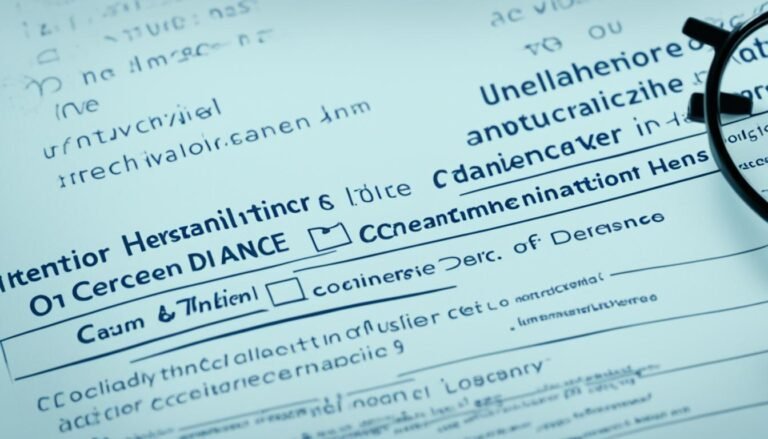Tobacco Products Directive: Compliance for Irish Healthcare Providers
Did you know that about 5,900 people in Ireland pass away each year due to smoking? This shows why it’s vital for healthcare in Ireland to follow the Tobacco Products Directive. The goal is to cut down the number of smokers to below 5% by 2025.
These days, Irish regulations on tobacco are stricter than ever. They highlight the need for healthcare workers to help people stop smoking. As part of the Tobacco Free Ireland Program, a team formed in April 2017 works hard. They suggest using both therapy and medicines to help smokers quit for good.
Key Takeaways
- Since 5,900 deaths from smoking happen yearly in Ireland, following the TPD is super important.
- The aim of Tobacco Free Ireland is to have less than 5% of the people smoking by 2025.
- Doctors and nurses are key in helping people stop smoking through regular talks and QUIT service referrals.
- Research proves that supporting people with therapy and NRT can double the odds of quitting.
- The TPD stresses the ongoing need to educate and empower healthcare professionals to help with stopping smoking.
Trying to lower the number of smokers in Ireland is a huge public health effort. It’s about more than just following rules; it’s hoping to save many lives each year.
Overview of the Tobacco Products Directive
The Tobacco Products Directive (TPD) is a set of rules in the European Union. It oversees how tobacco products are made, sold, and shared. Its main aim is to protect the health of people in the EU, which includes Ireland.
What is TPD?
The TPD was first introduced on 14 March 2014. The process continued with the European Parliament’s approval on 26 February of the same year. Soon after, on 19 May 2014, the directive became law. It requires countries like Ireland to have strict rules for tobacco by 20 May 2016. A key legal ruling on 4 May 2016 confirmed the directive’s standing.
TPD Implementation in Ireland
TPD implementation Ireland means making EU rules part of Irish law. To do this, Ireland has made its own laws to properly manage the tobacco market. It involves moving from many submission places to one online site. It also means keeping detailed records and checking regularly for rule-following.
Goals and Objectives of TPD
The key goal of the Tobacco Products Directive Ireland is to improve public health. It aims to lower the use of tobacco. Some of its big goals are:
- Putting bigger health warnings on tobacco packs.
- Banning the sale of some flavored tobacco, like candy flavors, with a step-by-step ban on menthol.
- Tracking tobacco products closely through the EU-CEG.
- Lowering the number of people who smoke, especially young folks.
- Making it easier to share product details, which improves the tobacco market’s openness.
TPD Guidelines for Irish Healthcare Providers
Following the Tobacco Products Directive (TPD) guidelines is key for Irish healthcare providers. This helps fight Ireland’s high smoking rates. About 22% of the Irish population smokes, where 18% are daily smokers. TPD guidelines aim to help healthcare providers support patients in quitting, thus lowering the medical costs from smoking.
Specific Provisions for Healthcare Providers
Healthcare providers need to pay attention to several main points under the TPD:
- Advising on quit strategies: They should use the most recent clinical information to give patients useful advice on quitting smoking.
- Prescribing medications: It’s important to give out prescriptions for medicines that help with withdrawal symptoms.
- Referring to specialized services: They should send patients to programs like QUIT for extra help.
By taking these steps, they can lower the health system’s costs from treating tobacco-related diseases. This currently leads to over 200,000 hospital visits a year, costing around €460 million.
How to Access TPD Resources
There are many online resources to help Irish healthcare providers comply with the TPD:
- National clinical guidelines on smoking cessation
- Referral forms for specialized smoking cessation services
- Patient education materials to help in quitting smoking
By using these tools, healthcare workers can aid the 57% of smokers who are thinking about quitting. They can also help the 47% who tried to quit in the last year.
Key Requirements for Healthcare Compliance
The Irish healthcare scene is under the watch of the Tobacco Products Directive (TPD). It says healthcare providers must keep to certain standards. Fitting these standards well can help lower the number of smokers to under 5% by 2025. Let’s look at the key elements providers need to follow closely.
One big part of meeting the rules is how patient care deals with quitting smoking. Doctors and nurses should always offer advice to help patients stop smoking. This not only helps patients but also lines up with Ireland’s big plan to be tobacco free. This plan comes with more than 60 helpful suggestions.
It’s vital for healthcare providers to be on top of the latest advice and treatments to help patients stop smoking. The Health Service Executive (HSE) is rolling out smoke-free zones and supporting healthcare staff. By sticking to these guides, providers can make sure they offer the best care. They can also help out with controlling tobacco use.
Healthcare workers also need to team up with local governments and help with local projects. These projects aim to stop people from smoking in some places. For example, smoking is not allowed in schools and places like parks and beaches.
There should be a special report every year to check on how well these efforts are doing. This check-up is very important. It helps keep things good and ready to face new challenges in fighting tobacco.
| Key Compliance Requirement | Details |
|---|---|
| Standardized Patient Care Practices | Incorporate cessation advice and support into regular consultations |
| Adherence to Clinical Guidelines | Stay updated with the latest treatment options and guidelines |
| Support for Tobacco-free Initiatives | Engage with local authorities and support community-based tobacco-free environments |
| Annual Monitoring and Reporting | Prepare detailed annual reports to monitor compliance and progress |
By keeping up with these guidelines, healthcare providers can meet the Tobacco Products Directive’s rules. This combined work aims to build a healthier, tobacco-free Ireland.
Tobacco Control Policies in Ireland
Ireland has made big strides in public health by improving tobacco control policies. These efforts are aimed at reducing smoking across the country. They focus on both helping people quit and preventing others from starting.
Tobacco Free Ireland Action Plan
The Tobacco Free Ireland Action Plan has set an aggressive goal of less than 5% smoking by 2025. It builds on the wider Irish healthcare regulations tobacco and includes strong strategies. These involve setting national clinical guidelines and running health campaigns.
Many people in Ireland still smoke, leading to over 5,200 deaths each year. The cost to healthcare is huge, amounting to about €500 million because of smoking. The habit is more common among the young and those with less money.
National Clinical Guidelines for Smoking Cessation
National Clinical Guidelines for Smoking Cessation provide a crucial framework. They help doctors and nurses guide their patients to quit smoking. The guidelines were thoroughly checked and approved in 2021.
Key strategies in these guidelines focus on support through behavior change, medications, and using nicotine replacements. Studies have shown that using Champix with NRT boosts quitting success. Also, a 28-day program can raise chances of quitting for good by five times.
| Year | Smoking Prevalence Rate |
|---|---|
| 2007 | 29% |
| 2012 | 22% |
The Tobacco Free Ireland Action Plan makes it possible for clinics to refer smokers to QUIT services. Healthlink, QuitManager, and specific forms are used for this. This approach helps doctors and nurses make a significant impact on public health.
Compliance Strategies for Healthcare Providers
To fully comply with the Tobacco Products Directive (TPD), healthcare providers should follow strategic steps. They need to use the best methods for applying the TPD rules. Also, they should make good use of the training and resources available.
Steps to Ensure Compliance
Start by looking closely at your healthcare practice. Figure out the areas you need to work on. Hold regular training for your staff to keep them up to date on how to help people stop smoking.
Make sure all patients are asked if they smoke. Then, offer them help to quit. By giving follow-up support, you keep helping them even after their first visit.
Best Practices in Implementing TPD
Using the best ways to apply the TPD helps a lot. For example, have a set way to check if patients smoke. Also, make stopping smoking part of the regular care you give.
Try to help in small ways and, if needed, with more intense help. Shockingly, more than 40% of smokers don’t get advice to quit. Fixing this would be a big deal. Think of managing these efforts like how safety at work is handled.
Training and Resources Available
There are many tools out there to help healthcare providers. You can get training on how to help people quit smoking. Plus, there are guides on what medicines work best with support.
Using data and advice from groups like the WHO can also make your strategies better. This way, the work to fight tobacco gets smarter over time.
By making these strategies just part of how you work every day, you help cut down on smoking. This, in turn, lowers the health risks linked to tobacco.
Benefits of Compliance with the Tobacco Products Directive
Following the Tobacco Products Directive (TPD) has many pluses. It makes healthcare better. TPD makes sure e-liquid nicotine in products is not too strong, keeping people safe.
In Ireland, TPD rules require small amounts of liquid in products. This makes it safer for everyone.
Also, TPD says all old products must be reported within six months of May 20th. New ones must be okayed six months before they’re sold. This makes sure all products are safe and hold high standards.
One standout point in TPD is letting EU countries stop online sales. About twelve countries have done this to stop kids from getting e-cigarettes. But, there’s still the fun of different e-liquid flavors. This supports safety while offering options.
The TPD has really made a big difference. It has been studied and found to greatly help with public health.
- Ensures healthcare providers are legally safeguarded.
- Contributes to reducing smoking rates.
- Demonstrates a commitment to public well-being.
By following TPD, healthcare workers are better protected. They’re seen as caring and keeping their patients safe. Advertisements for e-cigarettes in the media are also banned, showing the directive’s commitment to good practice.
Sticking to these rules works wonders against smoking. Studies show that around the world, tough rules stop people from smoking. The TPD is big in this success.
| Requirement | Details |
|---|---|
| Nicotine Concentration | Limited to 20 mg/ml (2%) |
| Tanks & Clearomisers | Maximum capacity of 2 ml |
| E-liquid Bottles | Maximum capacity of 10 ml |
| Product Notification | Existing products: notify within six months; new products: pre-notify six months before sales |
| Distance Sales | Option for member states to ban (around a dozen have implemented) |
| Advertising Restrictions | Prohibits advertising on TV, radio, newspaper, magazine, and internet display advertising |
Finally, TPD rules help more than following regulations. They bring better healthcare, trust, and safety. By sticking to TPD, healthcare workers stand up for public health. They make sure they are safe and caring places.
Conclusion
The Tobacco Products Directive (TPD) is crucial for Irish healthcare workers. It enforces strict limits to protect the public. These include only allowing 10 milligrams of tar in a cigarette, 1 milligram of nicotine, and 10 milligrams of carbon monoxide. By following these standards, they aim to greatly improve public health.
Manufacturers must also share what’s in their cigarettes. This makes everything clearer and ensures they follow the rules. Since half of long-term smokers risk serious illness, sticking to these rules could help save lives. It’s also key in reducing the dangers of smoking for others, especially children, in the long run.
Healthcare workers in Ireland should keep up efforts such as the HSE quit campaign and support for quitting. They should push for even stricter rules, plain packaging, and new taxes. With their hard work, a healthier Ireland is within reach, backed by the upcoming TPD changes.
Source Links
- National Clinical Guidelines – HSE.ie
- Regulatory Impact Analysis
- Revision of the Tobacco Products Directive
- European Tobacco Products Directive (TPD): current impact and future steps
- Tobacco control in Europe: progress and key challenges
- Tobacco control achievements and priority areas in the WHO Europe Region: A review
- Dáil Éireann díospóireacht – Tuesday, 13 Jun 2023
- Product compliance – ensure your product complies with EU rules – Your Europe
- Clinical-, System-, and Population-Level Strategies that Promote Smoking Cessation – Smoking Cessation
- Layout 1
- The EU Tobacco Products Directive (TPD): essential facts – ECigIntelligence
- Impact of the WHO FCTC over the first decade: a global evidence review prepared for the Impact Assessment Expert Group
- Medical devices: how to comply with the legal requirements in Great Britain
- S.I. No. 271/2016 – European Union (Manufacture, Presentation and Sale of Tobacco and Related Products) Regulations 2016.








